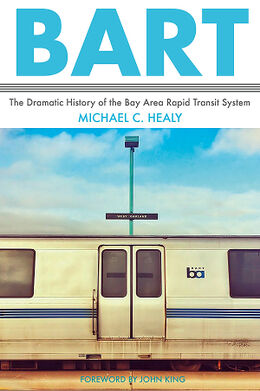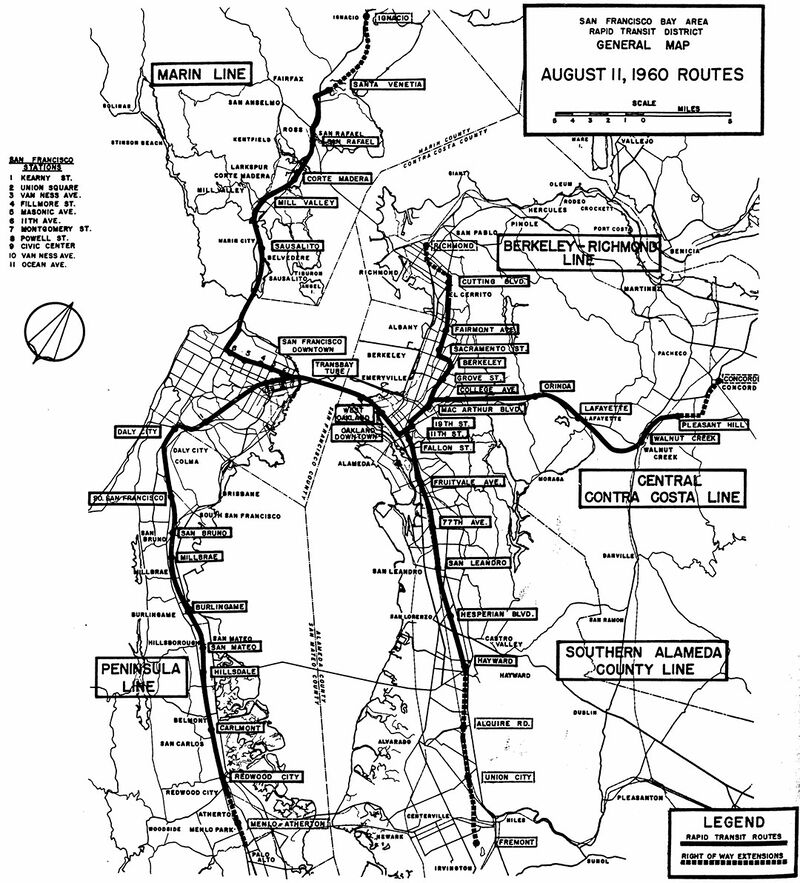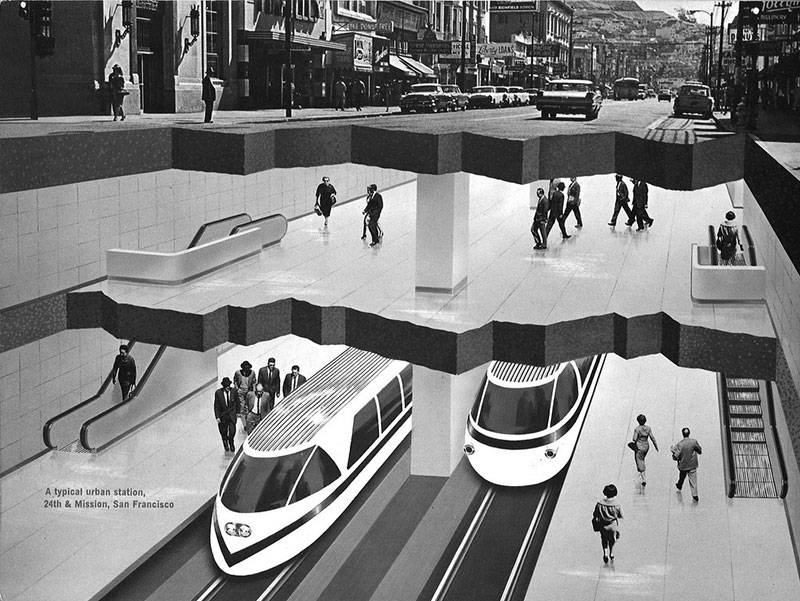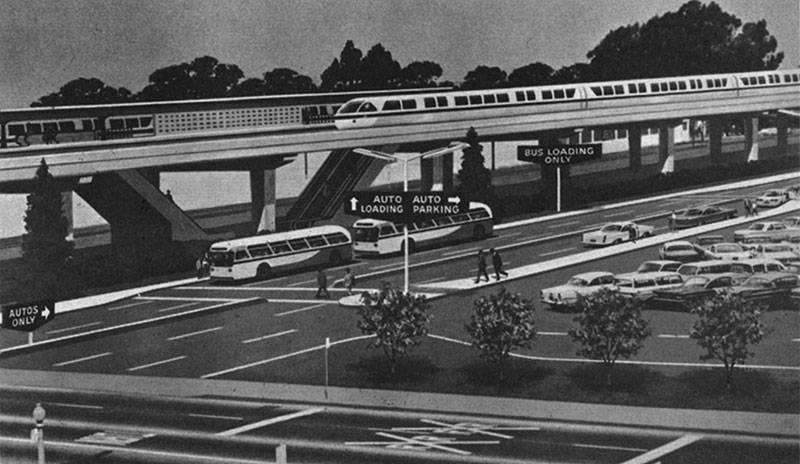Planning and Selling BART
Historical Essay
by Michael C. Healy
Text originally published in BART: The Dramatic History of the Bay Area Rapid Transit System Heyday Books: Berkeley CA, 2016
1960 BART route plan map.
Image courtesy Eric Fischer
During the course of their work, Parsons, Brinckerhoff, Hall & MacDonald (PBHM) engineers in 1954 carefully identified twenty-three specific areas that they considered bottleneck areas, or potential bottlenecks, to measure on heavily used corridors. These test lines, as they were referred to, were strategically located throughout the nine counties that make up the Bay Area. Another goal of this methodology was to determine the capacity of existing high- ways during peak periods. The results showed that capacity on corridors serving the outlying areas in the north, south, and east had not yet been exceeded, but these were not as yet high-density areas. Good land-use planning by incorporated cities and counties would have to be integrated with transportation planning in anticipation of future growth. In fact, PBHM planners regarded the coordination of existing surface transit, both local and interurban, with a new system as a critical component of the overall plan.
“The success of a rapid transit system will greatly depend on establishing relationships with already established carriers such as AC Transit, a regional bus system which had taken over the Key System routes, and San Francisco Muni,” the planners said. Both of these local systems, as well as other local systems, would play an important role as feeder or connecting lines for local destinations. In the outlying areas, private automobiles would more than likely be driven to stations where parking would be made available. However, it was estimated that for every parking space at a suburban station there would be ten or more passengers competing for it.
Meanwhile, the most severe congestion thus far identified by the “test lines” in 1954 was, of course, found on the routes between Oakland and San Francisco on the Bay Bridge. Stop-and-go traffic between Marin County and San Francisco across the Golden Gate Bridge was also recorded, as was heavy northbound congestion on the peninsula’s Bayshore Freeway along Highway 101. Southern Pacific commuter trains from San Jose offered some relief but did not go deep enough into San Francisco’s commerce center and thus could attract only a small portion of the market.
Although PBHM understood the importance of estimating demand for a rail rapid transit system in the years ahead, the planners were under no illusion that auto commuters would suddenly switch to mass transit once a fixed-rail system was in place. The fact that commuters were wedded to their automobiles argued for a regional free- way system, a network of arteries that would accommodate demand. But highways also had a greater social, environmental, and financial impact; once freeways reached capacity, they could not simply expand to accommodate growth, as a train system might do by adding cars in a much narrower corridor.
The original first-phase plan had recommended building 123 miles of routes and fifty-one stations in six counties. Santa Clara County ultimately dropped out of the first-phase plan because of several considerable concerns, the largest of which was that the first phase called for only two stations in Santa Clara, both ending at Palo Alto. The supervisors had a problem with the idea of their taxpayers through- out the county spending several years paying for services that wouldn’t directly benefit them. They were promised more stations once the second phase kicked in, but not everyone was convinced that would ever happen. Also, because Santa Clara at the time was predominantly an agricultural county with few commuters, the county’s Taxpayers Association strongly opposed being included in the District. The irony of the county’s decision to pull out of the District became clear in the 1970s and 1980s, when a burgeoning Silicon Valley, with its hundreds of thousands of new employees, saw Interstate 880, the road connecting Alameda and Santa Clara Counties, become one of the most congested corridors in the state.
The modified five-county first-phase rapid transit plan now called for the construction of approximately 118 miles of grade-separated double track, served by forty-nine stations. It would run from Santa Venetia, just north of San Rafael in central Marin County, south across a lower deck of the Golden Gate Bridge through San Francisco, and continue south along the peninsula to Palo Alto in San Mateo County on the west side of the bay. In the East Bay, the line would run from Richmond in western Contra Costa County to Fremont in southern Alameda County, and out to Concord in eastern Contra Costa County. Oakland would be the East Bay hub of the system.
The key link, as recommended by the 1947 Joint Army-Navy Board report, would be a transbay tube between Oakland and San Francisco. PBHM’s estimated price tag, again for a five-county system in 1953 dollars, was $716.5 million. Broken down, the costs were allocated as follows: track and structures, including a transbay tube, $353.3 million; stations, $74.8 million; yards and shops, $20 million; electrification, $71.6 million; signaling and dispatching, $30.2 million; right-of-way acquisition, $51.3 million; construction management fees and contingencies, $55.1 million; and other contingencies, including insurance costs, $60.2 million. These numbers become important in the historical context of BART’s actual cost because of how drastically they changed in just a few short years.
While PBHM’s final report included such detail, in fact it was not meant to be the definitive blueprint for what a regional rail system should look like, nor were the corridors suggested supposed to be unchangeable. In general terms, it was an overview of what was possible, feasible, and certainly needed to serve the nine-county region. It also went so far as to suggest potential different modes of rail transit available, such as a monorail, which would offer a super-modern look, or the more conventional double-track system. Without question, though, a modern system would have to be computer operated if it were to compete with the automobile.
When submitting its final recommendation to the Rapid Transit Commission, PBHM optimistically estimated that, if construction of the first phase of the rapid transit system began in 1957, it could be completed by 1962. Such a timetable was, of course, unrealistic, particularly since it would first have to be approved by the voters in the District’s member counties.
Bill Stokes At Work
After moving into his office on the sixth floor of the Flood Building in San Francisco, Stokes immediately set to work on his two primary objectives, or at least those he hoped to accomplish in the near term. The first was to gain respectability for the concept—in other words, to move the idea from a planner’s dream into the real world and create a public mindset that believed rail rapid transit was a serious and feasible venture. The naysayers were already legion in their denunciation of the idea of a vast regional rail system. They argued that it would be costly and disruptive to build. Some of the harsher critics were saying the whole thing was nothing more than a pie-in-the-sky fantasy concocted by a bunch of will-o’-the-wisp planners and had no basis in reality.
Some of the strongest opposition was coming from the American Automobile Association (AAA); the Southern Pacific Railroad, which was operating the commute service to San Francisco from the peninsula; and several papers in eastern Contra Costa County. (AAA would eventually change its policy and support rapid transit.) How much impact these organizations would have was as yet unknown. Several self-styled citizens groups that adamantly opposed the plan were also meeting secretly in private homes and at local halls.
Stokes’s first objective was integrated with his second objective, which was to find a general manager with certain credentials. Stokes worked closely with Falk in searching for potential candidates.
“We were like Batman and Robin,” Stokes recalled of those early days. “Falk had a keen understanding of what was needed. We worked well as a team.”
The person they finally selected was a conservative Republican named John M. Pierce, president of the Winter Oil and Gas Association. “We hoped that Pierce’s name and his Republican affiliation would bring important credibility to the District,” Stokes said.
Other powers granted the BARTD board by the state were the ability to issue general obligation bonds, with approval by the voters, to pay for the basic construction of the system, and the power to levy a tax on property to pay the interest and principal on such general obligation bonds until they were retired. Additionally, the District could issue revenue bonds to help pay for equipment, which would be repaid from the fare box. The PBHM analysts were certain that once trains began operating they would generate sufficient revenue to pay the system’s operating costs. Given the economics of public transit during the postwar years, this was a very optimistic view.
A major task now facing the BARTD board was to finalize plans for the design and construction of the first phase of the system. The original cost estimates would clearly have to be revised, given that they were based on a timetable of construction between 1958 and 1962 that was no longer realistic. Also, the original estimates did not include the cost for transit cars, fees paid to underwriters for the purchase of bonds, and basic start-up money. The BARTD board brought on Parsons Brinckerhoff again, along with the Tudor Engineering Company and the Bechtel Corporation. Together they formed Parsons Brinckerhoff–Tudor–Bechtel (PBTB). The joint venture immediately began to refine the work that had already been done by PBHM into a final five-county plan. It also began a seismic study of the San Francisco Bay Area, including the bay floor, in preparation for the design of the Transbay Tube.
While the engineering and final planning work was going on, a parallel effort now had to be made to educate the voters of the member counties about the benefits of a high-speed-rail rapid transit system. It would be touted as a critical component of a balanced transportation network and essential to the future well-being of the region. The population of the Bay Area had more than doubled between 1940 and 1960, and a decentralization of growth was making longer commutes into the major urban centers more problematic without any additional choices. In addition, interurban travel within the central counties by all forms of transportation was estimated to increase by 51 percent between 1960 and 1975. Freeways and bridges alone would not meet the growing need.
Another heralded aspect of a regional rail system was that, if approved by the voters, the system would also serve as an important planning tool, particularly for the outlying areas where growth was imminent. Train stations could attract cluster development around their peripheries or even be integral with development, thus creating a built-in ridership as well as preserving open space. Environmental issues were just beginning to come to the forefront as planners looked south to observe with alarm the sprawl in the Los Angeles Basin. Air quality was another potential benefit of such a system.
The Selling of BARTD
It was determined by the BARTD board that the project should go on the ballot during the general election to be held on November 6, 1962. This schedule would give the consulting engineers enough time to finalize a comprehensive plan. They basically had a little more than two years to sell a specific proposal to the public. The question was, would the voters tax themselves to pay off a debt of $716.5 million, which was the most current price tag for basic construction? Again, this figure did not include the cost of building the tube, which would be paid for with bonds backed by bridge toll funds, nor did the construction cost include transit cars, estimated at an additional $90 million. The Stanford Research Institute had indicated in its early cost estimates that bonds backed by fare-box revenue might be one way to pay for transit cars. This approach, however, would prove unfeasible, given that fare-box revenue would not fully cover operating costs.
Bill Stokes, who was elevated to assistant general manager in 1961, was charged with developing a comprehensive information campaign, a tricky business at best. The campaign would present what a modern rail rapid transit system might look like, where it would go, and generally how it would serve potential riders. However, the campaign could not cross the line into actually advocating for the transit system, since it was against the law to spend taxpayer dollars on promoting a publicly financed project. In other words, the information could not in any way advocate for a yes vote for the project, which went on the 1962 ballot as a general obligation bond referendum. But of course such advocacy was implicit in the information campaign.
As the nascent District began to take some shape, Stokes and his tiny staff set to work on a public relations strategy and specific plan to educate the voters in the five counties about the concept of a high- speed regional rail transit system.
“We determined that one of the best ways to give the public a sense of what they might eventually be voting for was to put together visuals which would show a very space-age-looking transit system in the con- text of specific locales using actual photos,” Stokes said.
As an example, we had an artist do a series of renderings showing sleek trains operating under ground, on aerial structures and at grade. Then we’d overlay or integrate the renderings in those areas photographed where the plan called for tracks to be laid, such as under Shattuck Avenue in Berkeley, or under Market Street in San Francisco. The photos would show cutaways that offered a strong visual component to the overall information campaign. Other renderings gave examples of clean, well-lighted, and very modern-looking stations, with marble concourses and in some cases the interior of stations with sweeping arches, and gleaming fare-gates, and ticket machines. These composite photo-renderings were then turned into a slide show as well as made available to the local press as glossies.
This illustration showing future space-age BART trains under a Mission Street was created as part of the public information campaign leading up to the 1962 bond referendum.
Image: BART
This illustration from 1962 showed what a future aerial line might look like.
Image: BART
Stokes said that between 1960 and 1962 he gave more than three hundred speeches and slide presentations to local gatherings, such as meetings of the Lions and Rotary Clubs, the Bay Area Council, the Commonwealth Club, and a variety of community groups around the five counties. “Most of the presentations were done in the evening, which made for long days,” he said.
While Stokes and his staff were working aggressively to inform the public about the proposed project, private concerns interested in seeing a successful vote at the ballot box were also gathering steam. A committee chaired by a Bank of America executive Carl F. Wente was raising money from the business community to pay for a parallel campaign calling for a yes vote for a regional rail transit network.
This private group, made up of San Francisco business leaders, hired a renowned public relations expert, Henry Alexander, to put together a strong advocacy campaign to supplement Stokes’s information pro- gram. One of the first things Alexander did was instigate getting BART on the ballot as Measure A. Another group, formed by the Zellerbach people, was also raising money to support the measure. As long as private money was paying the bills, it was perfectly legal to promote a yes vote on Measure A, and these groups did so with gusto. The campaign included newspaper ads, radio spots, and billboards, all calling for voter approval of the five-county plan.
Trouble Ahead
In September 1961, after a series of public hearings and a comprehensive draft plan published by PBTB was circulated among officials in the five counties, rumblings about possible defections began to surface. Later that fall, the first major threat to the five-county unit emerged when the Golden Gate Bridge, under the Redwood Empire Association Authority, refused to allow trains on a second deck. In a duel of engineering studies, two affirmed that a second deck of the bridge could handle trains, while two others paid for by the bridge authority concluded that trains would put too much stress on the support cables. Using the second deck to connect the proposed train system with Marin County had always been contemplated as part of the first-phase plan for BART, but the bridge authorities refused to budge on the issue. End of story. The only other option was to build another tube from San Francisco to Sausalito at an enormous extra cost, which would have to be borne by Marin County taxpayers. With virtually no industrial tax base to help support such a venture, plus opposition from environmentalists saying that BARTD trains would bring growth and crime to this staid bedroom community, the prospect for Marin looked grim. Some, however, thought the growth issue was a red herring. For the time being, the planners were giving more thought to this new wrinkle.
Then came another blow to the plan. In December 1961, San Mateo County withdrew from the District. County supervisors cited the fact that the peninsula commute service operated by Southern Pacific was already in place, and they did not want to burden home-owners with any additional property taxes. In fact, it came out later that the county board of supervisors had been lobbied heavily to drop out by a prominent and well-respected real estate developer on the peninsula, David D. Bohannon. Coupled with the aforementioned concerns, San Mateo supervisors were just too uneasy about putting BARTD on the ballot. With San Mateo out, the tax base to pay for the first phase was considerably weakened.
Looking north to Marin County again, the BARTD directors were concerned that Marin, given the circumstances, could very well vote against the project and possibly sink the entire enterprise. Reluctantly, the BARTD board voted to request that Marin County supervisors withdraw their county from the District. There was debate on the issue by the supervisors, but in the spring of 1962 they voted the county out, noting that they were doing it involuntarily. Prior to the November 1962 election, Marin made overtures to be let back into the transit district, but they were rejected by the BARTD board, who again feared that Marin would drag down the entire project.
The Geary line that would have connected to Marin County in the original plan to run BART across the Golden Gate Bridge.
Map courtesy Eric Fischer

Originally published in BART: The Dramatic History of the Bay Area Rapid Transit System Heyday Books: Berkeley CA, 2016




